The voltage waveform used in 3-phase secondary injection testing can affect the results in several ways:
- Accuracy of Test: The waveform accuracy is crucial for obtaining reliable test results. If the voltage waveform generated by the secondary injection test set deviates from the expected waveform, it can lead to inaccuracies in the test results. This is particularly important for testing protective relays, which rely on precise voltage and current waveforms for correct operation.
- Transient Response: The transient response of the voltage waveform, including rise time, settling time, and overshoot, can impact the performance of the protective relay under test. A waveform with fast transients may stress the relay more than a slower waveform, potentially affecting its response time and accuracy.
- Harmonics and Distortions: The presence of harmonics and waveform distortions can affect the behavior of the protective relay and the accuracy of its measurements. Harmonics can cause false tripping or incorrect operation of the relay, especially if the relay is sensitive to high-frequency components in the waveform.
- Frequency Variation: Some secondary injection test sets allow for testing at different frequencies, such as 50 Hz, 60 Hz, or variable frequency. 3 phase secondary injection test set The frequency of the voltage waveform can affect the impedance of the relay under test and its response to fault conditions. It’s essential to select the appropriate frequency for the specific application and relay being tested.
- Waveform Stability: The stability of the voltage waveform over time is critical for maintaining consistent test conditions and obtaining repeatable results. Any fluctuations or instability in the waveform can introduce uncertainty into the test process and lead to inconsistent test outcomes.
- Compatibility with Relay Specifications: The voltage waveform generated by the secondary injection test set should meet the specifications and requirements of the protective relay being tested. It’s essential to verify that the waveform parameters, such as voltage amplitude, frequency, and waveform shape, align with the relay’s operating characteristics to ensure accurate and meaningful test results.
In summary, the voltage waveform used in 3-phase secondary injection testing can significantly influence the accuracy, reliability, and repeatability of the test results. It’s essential to use a secondary injection test set that generates a stable, accurate, and appropriate voltage waveform tailored to the specific requirements of the protective relay under test.
